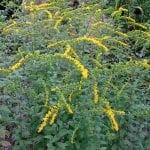- Cultivar habit
- Cultivar foliage
- Cultivar flowers
Scientific Name:
Solidago rugosa
Common Name:
Wrinkle-leaf Goldenrod
Scientific Name Pronounciation:
so-li-DAY-go roo-GO-suh
Plant Type:
Perennial
Plant Hardiness Zones:
3-9
Plant Hardiness Zone(s):
Usual Size:
2-5 ft H
Flower:
Small yellow flowers arranged in thin sprays of arching stems. Individual flowers are 1/8" across, consisting of 4-8 ray florets and a similar number of tubular disk florets
Bloom Time Notes:
Summer
Leaf:
Medium green, alternate, with a wrinkled appearance because of the indentations of their pinnate veins
Fruit:
A seed.
Wildlife:
Used by long-tongued bees, short-tongued bees, wasps, flies, beetles, and butterflies. The caterpillars of many moths feed on the foliage.
Natural Habitat:
Low woods; meadows; old fields; pine barrens; bogs.
Propagation:
Seed, division
Bloom Time:
Sun or Shade:
Companion Plants:
Cultural Notes:
Wrinkle-leaf Goldenrod (Solidago rugosa) is a handsome perennial with a spreading habit. It is not as aggressive as Solidago canadensis, but the clump will increase over time. A popular cultivar of this species is known as 'Fireworks.'
Contrary to popular belief, goldenrod is not a source of fall allergies because its pollen is not light enough to be transported on the wind. Goldenrods are insect pollinated and highly sought after by native bees and butterflies for pollen and nectar. Fall allergies are associated with wind-pollinated plants such as ragweed (Ambrosia artemisiifolia), an annual plant with greenish flowers that is often unnoticed.
Other Common Names: Rough-leaf Goldenrod, Rough-stem Goldenrod




